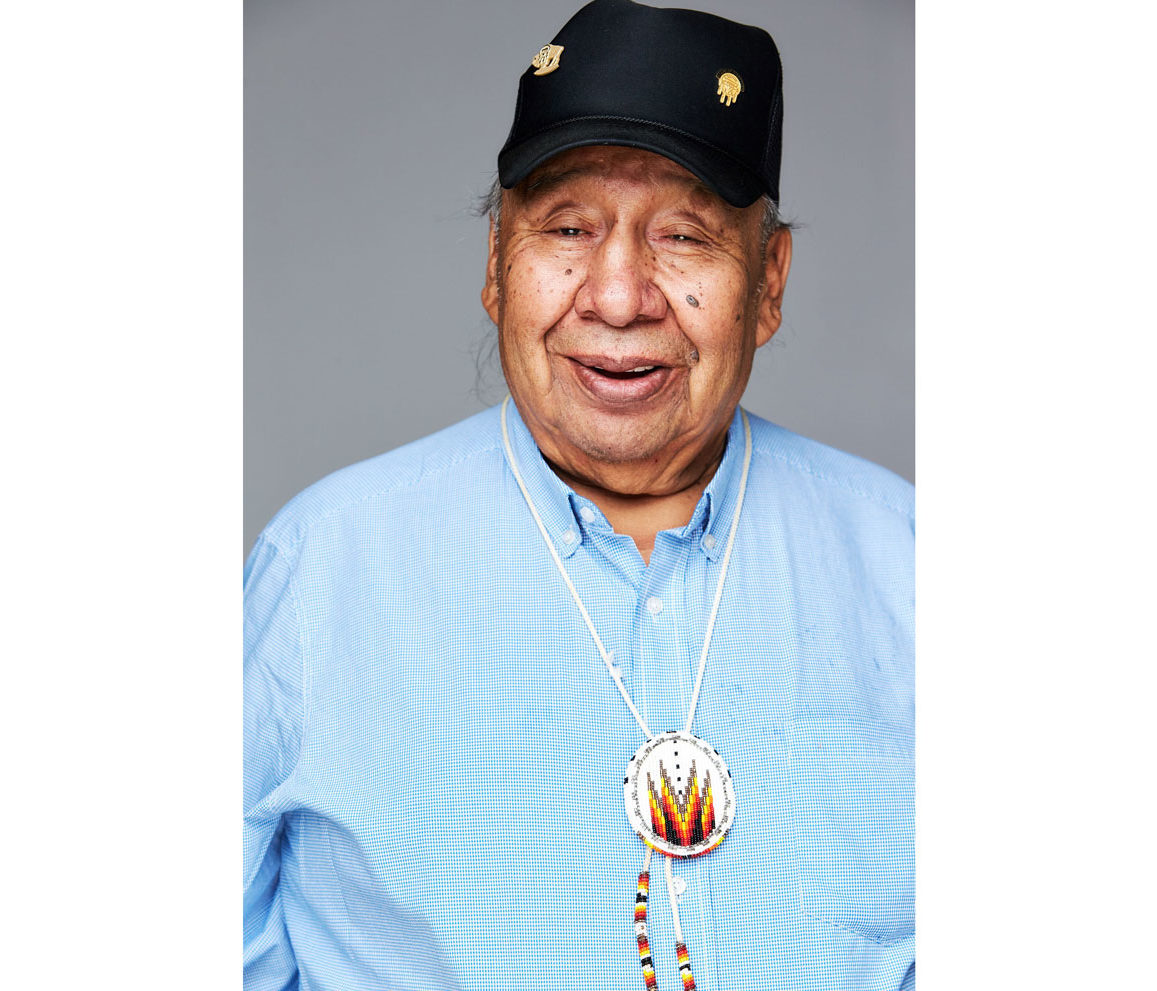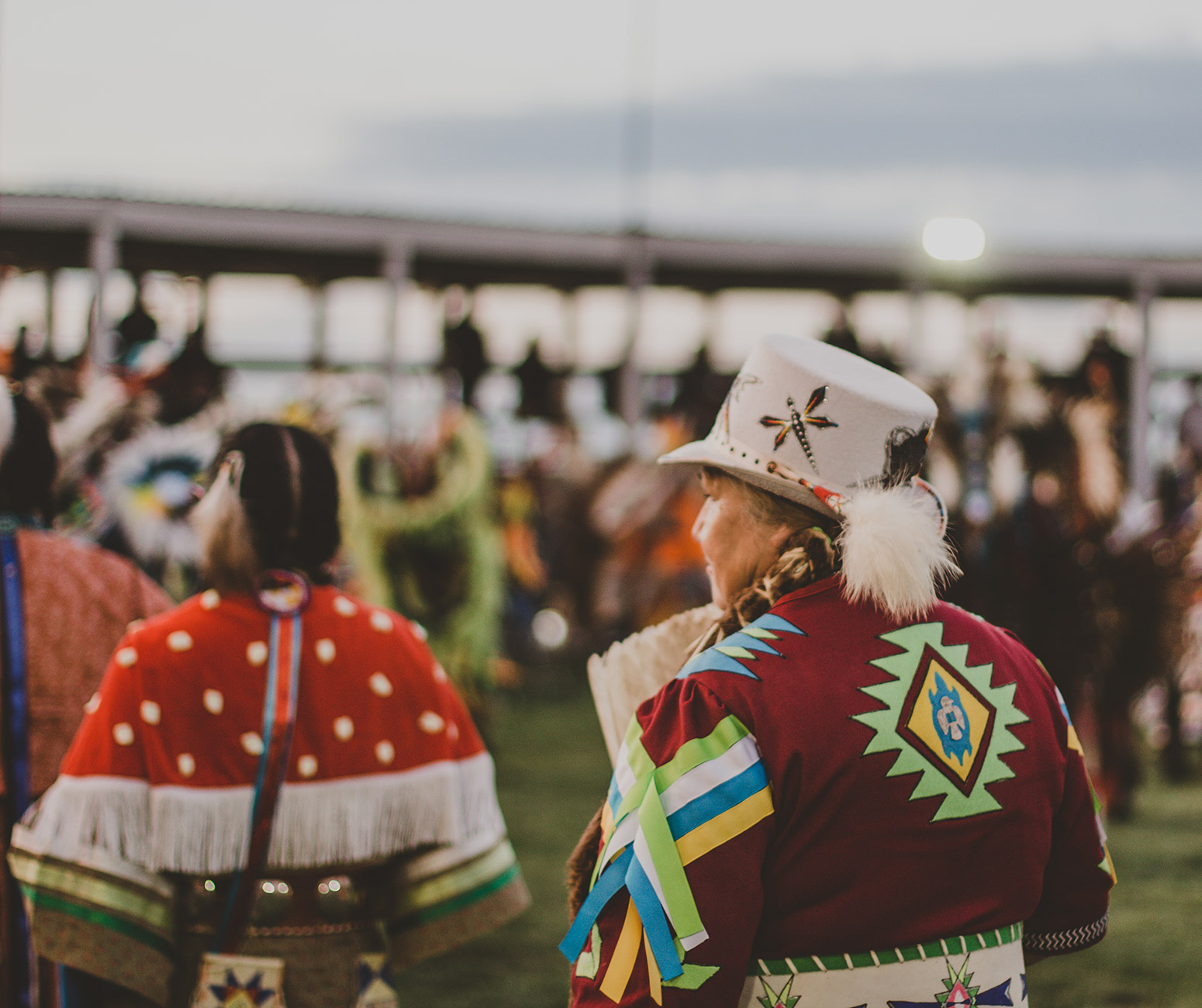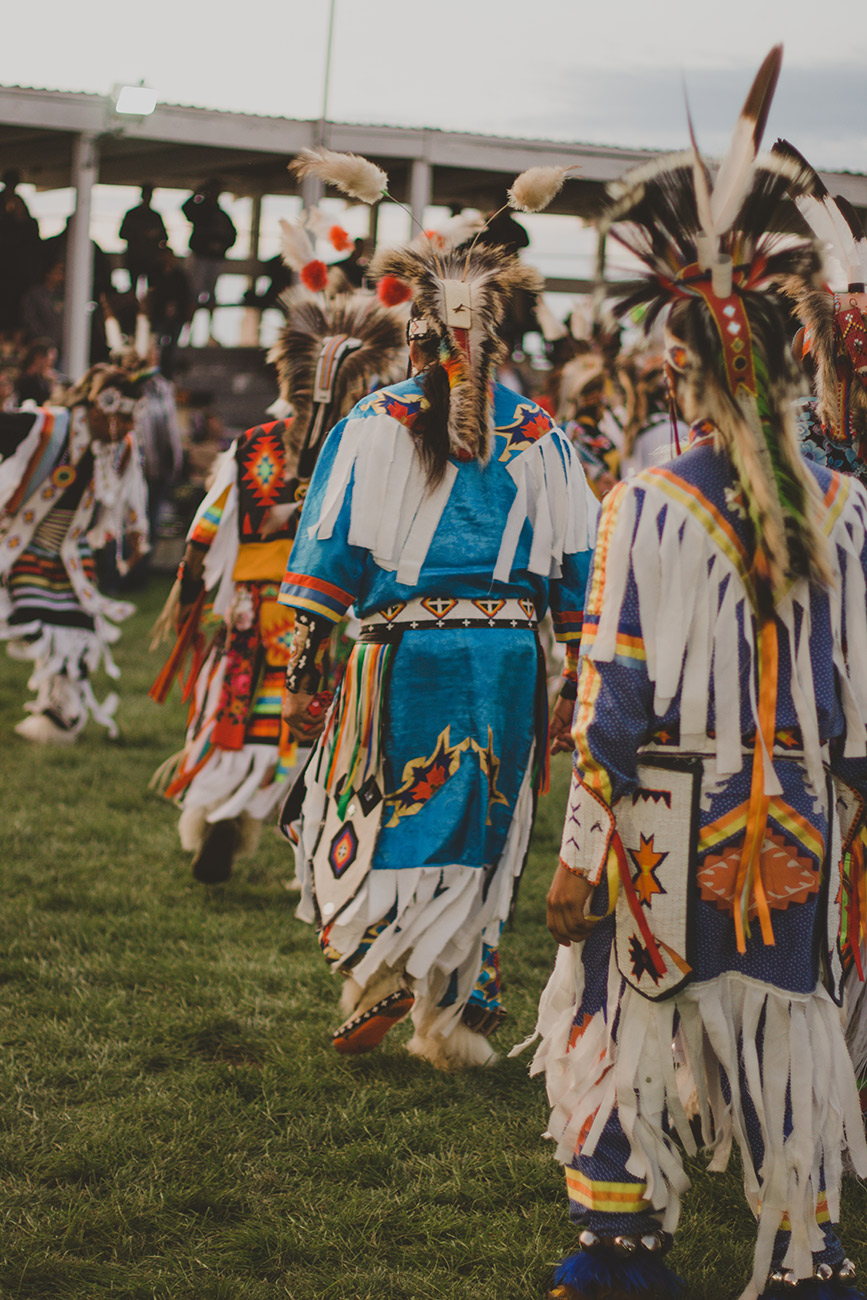Cheyenne River Reservation, South Dakota
Pow Wows: A Celebration of One Year, Happiness, Guidance, and Protection | Cheyenne River
A respected elder in the community, Ben Elk Eagle is a fluent Lakota speaker and is passionate about sharing traditional values with the younger generation. In this interview, conducted on July 16, 2020, Elk Eagle discusses the role of pow wows within the community and the changes he has seen over his lifetime. —Annie Coombs and Zoë Malliaros, The Lakota Nation and the Legacy of American Colonization editors
Audio Player
Listen to Ben Elk Eagle share the Lakota terms and their meanings for the pow wow.
This audio recording is excerpted from the conversation that has been transcribed and edited in the interview below.
Annie Coombs and Zoë Malliaros interviewed Ben Elk Eagle in 2020.
The following has been edited for length and clarity.
Annie Coombs and Zoë Malliaros (AC and ZM): Can you talk about the role and social significance of pow wows in the community? Have they changed over time?
View a map noting the locations of communities and sites mentioned in this interview, along with a discussion of land ownership and governance helpful in understanding this conversation.
Ben Elk Eagle (BEE): I saw pow wows growing up as a celebration of one year, of happiness, guidance, and protection. Every year at the same time, the people that live like a clan came together. Each family honors their family, and then during that time, there’s a name-giving honoring the past. Some of the young people were encouraged to make their regalia: costume, they call it. And these young people, they work on their costume the whole year. And when that time comes, they put their costume on and they come into the circle for the pow wow. During that time, the family always gives appreciation for other things that happened during that time, like people helping the youth or people that are struggling, or people that have lost someone. So a pow wow at one time, was like a gathering to celebrate the year.
[In our community], people mourn for a year after they lose a family member or somebody passes on. When that year [ends], they do the honoring with them and passing a name. If an elder passes away, the Lakota name that elder has carried all this time, we give it to a younger person.
Now, there’s other things that happen during the pow wow. There’s foot races and sports. It’s not a thing that happened during that time [during his youth]. I enjoyed it at that time, because today, it’s all a competition.1The annual Labor Day Pow Wow now includes a fair and rodeo in addition to dancing. They compete against each other—which, to me, it’s not nice to compete against each other. It was different. A pow wow was social dancing. Everybody comes out and they dance, like an exhibition. They use dancing to show their style, and there was no competition involved at that time. Everything was just for happiness. I think it started changing, probably 1960 or ’70.

Cheyenne River Labor Day pow wow, fair and rodeo youth wild horse ride – Eagle Butte 2017, a photograph by Dawnee LaBeau
AC and ZM: Is there still a time when the whole community comes together?
BEE: They call it Intertribal when everybody comes out and dances. Elder people will help their young ones to dance, to hold hands and go around with them. And then, pretty soon, the child will kind of understand what’s happening, and they start dancing.
I danced until I was about 16 years old. When I was younger, I had a grandmother that helped me make a regalia, or costume. My cousins and I, there were five of us who danced together as a family, representing our family.
AC and ZM: Is the big Labor Day pow wow something most people across the reservation plan to come together for?
BEE: Sometimes people throughout the reservation come and camp out, and they socialize. The family puts on a feed, and friends from different reservations, they come together and they share that meal, maybe have the name-giving ceremony, where a relative is giving a grandma’s name or a grandpa’s name to a young baby.
So what I see, at that time, was everybody helping each other get the event together. It took about two days for the activity. Now, they’ve been going three days, and sometimes they go for a week while gathering. That’s when all the tribes around from different places come to compete. It’s a competition of who’s got the biggest prize money, or who’s got the biggest people that they can attract.
Growing up, everything was a ceremony. There are some people who are asked to speak about different things: women talk to the young ladies, the men talk to the young boys. They share different things with the young people so that they’re aware of what they’re going to face in the future. That’s what I see at that time.
Grand Entry—Oglala Lakota Nation Wacipi [Pow Wow] & Fair 2017, Pine Ridge. Credit: Annie Coombs
Today, young people, they usually start dancing with friends that are dancers. And usually the elders will be dancing when the young people go the other way, clockwise and counterclockwise. The elders give them encouragement to keep their belief. They call it a belief when you have belief or dream that you will be able to do that type of dancing. One time there was a young man that was dancing and didn’t have the regalia or costume. That fall, they asked that young man to come in the middle, and this family made a regalia costume for him. Boy, that was a nice one. I thought that was pretty neat, because he danced quite a while, but he never had his own regalia. People wanted him to succeed, so they helped him make that costume and gave it to him. So that’s the way they honor or respect each other. All the time, you see them respect and pray together.
The pow wow grounds are for pow wow, for celebration. We always called it “the celebration” before: the Lakota for celebrating, happy gathering, Kawita kyo wacipi: happy gathering. After that, the name pow wow came up.
AC and ZM: What’s the role of food at the pow wows, both present-day and in the past?
BEE: The people who coordinate the pow wow, they usually coordinate the feed. You bring a favorite dish, like a potluck. At our gatherings, everybody usually brings something, part of a soup, or frybread, or wojapi. At that time, there was not much like the meals today; they were all traditional. And they share that food in the evenings, when everything is being wrapped up. That’s when they eat, they have a feed. In the morning it starts again, and then about noon they feed again.
AC and ZM: Can you describe the important features of pow wow grounds?
BEE: At the pow wow grounds, they have the arbor to represent the circle of people. They’d be covered with pine, like pine leaves or branches, to create shade for people to have a place to sit. And then they have a special place for drums and singers. Usually they try to put them in the four directions when they come in.
We believe that there’s four directions, which are represented by different beliefs. The West is represented, usually, by the color red. That means evenings. Sometimes you could look towards the west as the sun goes down, there’s some places you could see red color. And then the North is where we believe that buffalo move: that starts closer to the people so that we are able to hunt and get ready for the winter. East is represented by all the deer animals, the elk and three types of deer. Each deer, they have some kind of a medicine that they carry. And they take that medicine and they prepare it and use it to heal different sickness. And South is where all the animals go back that way in the wintertime, and summertime they come back. When they come back, they bring strength and positive things that we need.
AC and ZM: Does the experience of pow wows feel different if you live in town, Eagle Butte or Dupree, versus in a community like Iron Lightning or Bridger?
BEE: People are always dancing. They all dance during wintertime inside their homes. Then about April or May, when it starts warming up, they start gathering to go start their pow wow season. It happens every summer. In spring and winter, it kind of slows down, but still, there’s people that have the pow wow. On certain days, maybe it’s somebody’s birthday but it’s not a big event, just family members or friends, maybe 10 or 15, 20 people come together. Then they have this social gathering, as people share stories or announcements or whatever is going on at that time, and planning. Then when the pow wow season starts, you know, they renew the ways of their activities and planning. Maybe their plans will be a little bit different for that summer. Like, for instance, this season is pretty hot, so people don’t gather until evenings, when it cools off. That’s when they come out and come together. They have a schedule. Each community that’s having a gathering, they usually have committees: singing, dancing, different committees.
AC and ZM: Can you share a brief history of your childhood and education?
BEE: I was born in 1948 and raised in Iron Lightning. After finishing sixth grade, you have to go to a different school, because that day school doesn’t go any further. I went to St. Joe’s up to eighth grade2Founded in 1927, Saint Joseph’s Boarding School was part of the broader boarding school system set up to remove Native American children from their homes and assimilate them into the dominant society., then I came back to Eagle Butte and Dupree. Around the beginning of senior year I went to the military, and there I finished my GED.
We spent at least nine months in boarding schools, and we have, just like today, three months of school vacation. Boarding school was required. If we didn’t go, our parents would be charged for neglection. So most of the time, we learned everything from the boarding school. I enjoyed it after I got used to it.
Lakota language was the first language I learned, because all my family’s relatives spoke Lakota, and they always do that. They always do everything the traditional way, the Lakota ways of doing things, like hunting and picking wild fruit. And pretty much I was attracted to my grandfathers. So they taught me a lot of things as they were moving along. That was a good time. They always give time and talk to us, just three of us. It was two cousins and me there. We liked to go visit with [my grandfather]. Lot of stories I remember he had.
AC and ZM: Where did you learn Lakota values?
BEE: I didn’t learn my values in school. I was taught at home, growing up with my family. They all respect each other, greet each other: mother, father, sister, brother, grandmother, grandfather . . . Everything is addressed to each one of us by the old elders. And so we learned, we understood. In boarding school, I learned about the religion part, Christianity. But I never really learned anything about actual life.
I think a reason why the youth or people today are struggling, is because some of the parents were taken away from their families when they were young, placed out someplace away from their families. So that made a fear of the [Lakota] values. So that’s why today they don’t teach those to their kids, because they weren’t taught that.
Biographies
was born and raised in Iron Lightning on Cheyenne River Reservation. He attended multiple boarding schools starting in sixth grade, including St. Joseph’s Indian School (off the reservation) and boarding schools in Eagle Butte and Dupree. Elk Eagle held several jobs on and off Cheyenne River, including service in the US military, the Tribal police, and the Tribal vocational rehab program. Recently, he served on the Tribal council representing District 3 and now works with the Sioux YMCA as a cultural advisor.
The views expressed here are those of the authors only and do not reflect the position of The Architectural League of New York.



